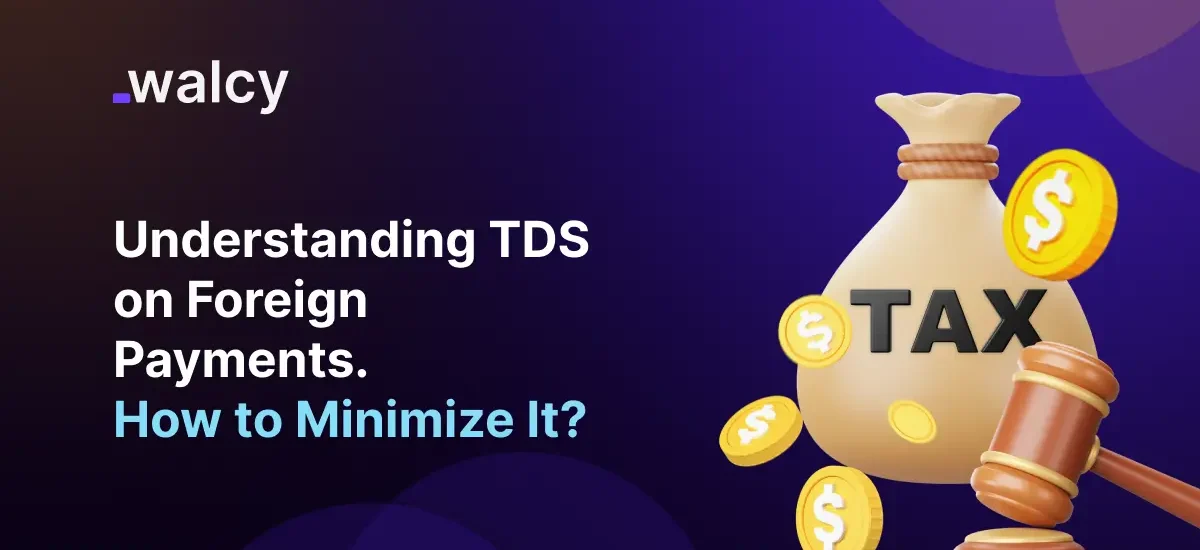Technology has advanced to the point that most of our world is already shifting from manual systems to digital and this does not escape cross-border transactions. Nowadays, businesses are spread across the world. Businesses or people who engage in cross-border transactions have become more common because of a technological reach and also due to huge migration taking place for the purpose getting an opportunity now trades on global scale.
Everyone has at some point made foreign payments which is a very usual thing to do while purchasing services, software products subscribing to OTT platforms, etc, or in case of making royalty payments. Nevertheless, there is one thing that applies to cross-border payments in India and it has tax implications i.e. Tax Deducted at Source (TDS).
Businesses would have to comply with tax norms and also not end up costing them avoidable expenses — so it matters for both businesses as well as individuals to understand how TDS on foreign payments operates.
What is TDS on Foreign Payments?
TDS is imposed as per the Indian Income Tax Act, of 1961 and it was introduced to deduct some percentage of tax by the payer in making a payment to a payee. Curiously, whenever specific transfer pricing payments are paid to non-residents TDS under Section 195 of the Indian Income Tax Act must be done.
So, what is Section 195? Every person, whether a resident or non-resident making payment to one of the other kinds as taxable in India must deduct tax at source on such payments according to the prevailing rates. You need to be aware of what transactions are covered under Section 195 where every payment needs to be deducted TDS managed by the payer.
It generally includes, but is not limited to, interests, fees for services, dividends shared, royalties, capital gains, and anything that is chargeable under the provisions of the Income Tax Act.
Why is TDS on Foreign Payments Important?
Compliance with the Indian Law:
It is a fundamental function and reason to comply with the Indian Income Tax Act of 1961; any payment to a non-resident that is taxable in India requires TDS deduction at the applicable rate.
- If not complying with TDS regulations, the penalties can be above 100% to 300% of the deductible amount.
- Non-deducted tax generally can be calculated at 1% per month from the defaulted date.
- A continued offense and non-compliance will surely lead to prosecution. TDS deductions are not about avoiding payments but maintaining a company’s reputation and goodwill.
Avoiding Double Taxation:
When an individual or a business entity pays taxes twice in different countries, this is deemed to be double taxation. Therefore, proper implementation of TDS will ensure that the tax is deducted at the source, which is India. For example, if an Indian consulting company hires a consultant for a specialist job, the company should deduct the TDS at a rate of 10% on the hiring price; however, the specialist must possess an Indian PAN in India.
The 10% TDS is deducted in India, and the specialist can claim a credit for the paid tax in the US; this way, he avoids double taxation. However, there must be an inter-governmental taxation agreement like the Double Taxation Avoidance Agreement (DTAA).
Rates and Applicability of TDS
The rates for TDS on foreign payments depend on several factors, which are as follows:
Type of Payment: Different rates apply to various categories, like royalties, interest, and technical service fees. In the case of royalties, a TDS rate of 10% applies. For interest payments, TDS on interest payments can range from 5% to 20%, depending on the DTAA. For technical service fees, the TDS usually ranges from 10% to 25%.
Double Taxation Avoidance Agreements (DTAAs): India has signed DTAAs with various countries to provide relief from double taxation. The DTAA rates, if applicable for the payee country, often differ from the standard rates under the Income Tax Act.
Has Permanent Account Number (PAN): Higher rates of TDS (20% or more) apply if the non-resident does not have a PAN in India.
Here’s a brief overview of TDS rates under different scenarios:
Royalties: 10% under the Income Tax Act; 10% – 15% under DTAA
Fees for Technical Services: 10% under the Income Tax Act; 10% – 15% under DTAA
Dividends: 20% under the Income Tax Act; 5% – 15% under DTAA
Capital Gains (Long-term): 10% under the Income Tax Act; rate varies under DTAA by country and type of gain
Capital Gains (Short-term): 15% under the Income Tax Act; rate varies under DTAA by country and type of gain
How to Minimize TDS on Foreign Payments?
Before thinking of minimizing TDS on foreign payments, one should strategically plan the payments, take time to understand the relevant tax treaties, and leverage available provisions on TDS. According to us, here are some valid ways to minimize TDS on Foreign Payments:
Leverage Double Taxation Avoidance Agreements (DTAA)
India now has DTAAs with over 90 nations, including developed nations with large economies like the US, the UK, Australia, Canada, and Singapore.
Thanks to DTAAs, they provide a lower rate of TDS than what is generally prescribed under the Income Tax Act.
To use the benefits of a Double Taxation Avoidance Agreement (DTAA), follow these steps:
Check if You Qualify: Make sure that the recipient of the payment is eligible for DTAA benefits; you can check the income tax website for the related information. They need to be a resident of a country that has a DTAA with India.
Get a Tax Residency Certificate (TRC): The non-resident should obtain a TRC from the tax authority in their home country. This certificate is mandatory to claim DTAA benefits.
Fill Out and Submit Form 10F: The non-resident must fill out Form 10F and give it to the Indian entity making the payment. This form includes specific details required by Indian tax rules.
Apply the Correct DTAA Rate: The Indian payer should use the lower tax rate mentioned in the DTAA to deduct tax (TDS) on the payments made to the non-resident.
By adhering to these suggestions, businesses can leverage the advantage of lower withholding rates, reducing their TDS liability.
Read about: Cheapest Way To Transfer Money Abroad | Ultimate Guide-2024
Properly Classify the Payment
The classification of a payment is crucial in determining the applicable TDS rate. There will be some instances where payments can often fall into more than one category, which leads to varying TDS rates. For instance, a payment made for SEO content could be considered a royalty or a payment for the use of a copyrighted article, depending on the nature of the license and the agreement’s terms.
Strategies for Proper Classification
Review Agreements Carefully to make sure that the agreements with foreign parties are drafted carefully, and the payments are classified in a way that levies lower TDS rates.
Since TDS can be quite complicated, we suggest consulting with tax professionals to accurately classify payments and apply the most relevant and lower TDS rates.
Apply for a Lower Withholding Certificate
The Income Tax Act’s Section 197 permits the non-residential receiver to request for a certificate from the Indian tax authorities allowing the payer to deduct tax at a reduced rate or not at all.
To obtain a certificate for a lower withholding tax rate, follow these steps:
The non-resident needs to submit an application Form 13 to the Income Tax Department. This form includes details about their income, estimated tax liability, and reasons why a lower tax deduction can be justified.
The Assessing Officer for the certificate will review the application. They will give a certificate specifying a lower rate for TDS (Tax Deducted at Source) if everything is in order, but approval must be obtained first, and the length of time required may vary depending on whether the TDS penalty applies.
Once the certificate is received, the non-resident should give the certificate to the payer; thereby, the payer can then deduct TDS at the lower rate approved in the certificate.
Grossing Up Mechanism Can be Utilized
This means that the foreign party can receive a specific amount after the deduction of the applicable tax; the payer then is responsible for covering the TDS on behalf of the non-residential recipient living abroad. Therefore, when the payment to the foreign party is agreed to be “net of tax,” the payer must bear the TDS liability.
It works through:
Determination of the Gross Amount by adding the TDS liability to the net payment amount.
Finally, the Application of TDS on the Grossed-Up Amount and deduct TDS on the grossed-up amount; this ensures the recipient receives the net payment as agreed.
As a disclaimer, grossing up might not always reduce the absolute amount of TDS; however, it can help in cases where contracts mandate it.
Read about: All About Overseas Payments (2024); Comprehensive Guide
Understanding Exemptions and Thresholds for TDS
Important Exemptions to Take Note of:
Under Section 172 of the Indian Income Tax Act, payments made to foreign shipping firms for freight are usually free from TDS.
Payments given to non-resident sportsmen or sports institutions are excluded under certain provisions of the Income Tax Act. These exclusions promote international sporting competitions and events for sportspeople.
Certain payments are only liable to TDS if they exceed certain cutoff limits; any transaction below this cutoff is not liable for TDS payments.
Treaty Shopping
Treaty shopping utilizes benefits from tax agreements between India and other countries to structure your cross-border transactions. It is a kind of a hack. To exemplify, if India has a tax treaty with another country that offers a lower tax rate, you can route your payments through that country to save on taxes. However, ensure your reduction in taxes and treaty shopping complies with the country’s laws.
Be very vigilant of anything that could be seen as tax evasion in both India and the third country. Indian tax authorities scrutinize payments that are purposely done with the intention to avoid taxes.
Update Contracts Regularly
Tax laws regularly see amendments and evolve; therefore, contracts with foreign entities must be reviewed regularly. This ensures compliance with the ever-changing tax laws, and you can amend your provisions to help minimize TDS.
Some of the best practices for contract management:
- Specify the party responsible for TDS and the applicable rates, considering DTAA benefits.
- Integrate clear provisions for dispute resolutions related to tax deductions or rates.
- Set provisions for renegotiation of terms to amend tax provisioning in response to changes in tax laws or interpretations.
Conclusion
To minimize TDS, one needs to be proactive by understanding the applicable income tax laws, DTAAs, TDS thresholds, and tax exemptions. Also, since taxation provisions are complicated, seeking help from tax professionals is always suggested. They will regularly review the contracts, keeping abreast of changes in the income tax laws.
TDS on foreign payments can indeed be complex, but with the right strategies, businesses and individuals can ensure compliance with prevailing law while minimizing tax costs. By leveraging the suggestions outlined in this blog, one can achieve significant savings, optimize cash flow, learn about the prevalent laws, and enhance their competitive edge in the global marketplace.



